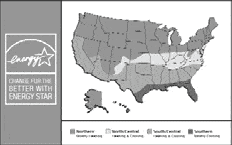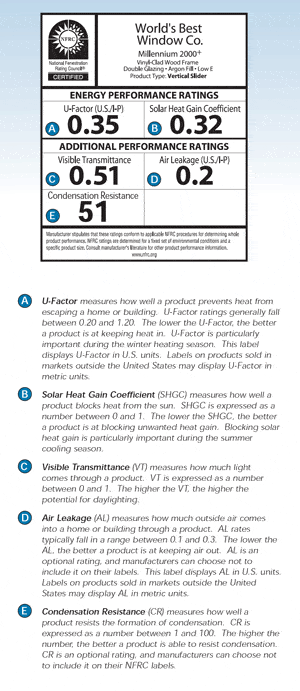Tools
- Getting Started On Your New Windows
- Selecting The Right Window
- Types Of Windows
- Window Options
- New Construction Window Measuring Guide
- Replacement Window Measuring Guide
- Windows Checklist
- New Construction Window Installation Guidelines
- Upgrade Your Home’s Energy Efficiency
- Andersen Windows Warranty Service
- Andersen Windows & Doors Virtual Showroom Tour
- Care, Maintenance and Troubleshooting of Andersen Windows and Patio Doors
In today’s market, architects, builders and consumers are challenged by the many choices of window products. What is the best way to choose windows, doors and skylights for homes and offices? If you have questions about how to choose energy efficient windows, the National Fenestration Rating Council (NFRC) has the answers. This information has been provided as a courtesy from the NFRC and used with permission.
1. Look for the NFRC Label
NFRC is a nonprofit organization whose goal is to provide uniform, accurate information about the energy performance of windows, doors and skylights. In addition to publishing consensus standards (for consistent ratings), NFRC administers a third-party certification and labeling program to provide the window buyer with verified product information. So look for an NFRC label on windows to compare products on a fair and equal basis.

2. Compare Product Performance
The NFRC label provides information on how a window performs. The two most important energy ratings are U-factor and Solar Heat Gain. By reviewing the label information, consumers can make an informed choice about the product that is best for their individual situation.
What is U-factor?
U-factor is also known as thermal transmission. It is a measure of the rate of heat loss through a product. Therefore, the lower the U-factor, the lower the amount of heat loss. In cold climates, where heating bills are a major concern, choosing windows with lower U-factors will reduce the amount of heat that escapes through a window from inside your house to the outside.
What is Solar Heat Gain?
The Solar Heat Gain Coefficient, also know as SHGC, measures the rate of heat gain through a product. Therefore, the lower the SHGC, the lower the amount of solar heat gained. In hot climates, where air conditioning bills are a major concern, choosing windows with lower SHGC will reduce the amount of heat that comes in through your windows from the outside.

3. Look for the Energy Star Label
The U.S. Department of Energy and the U.S. Environmental Protection Agency have developed an Energy Star designation for products meeting certain energy performance criteria. Since the energy efficiency performance of windows, doors and skylights can vary by climate, product recommendations are given for four climate zones: a mostly heating zone (Northern), two heating and cooling zones North/Central and South/Central); and a mostly cooling zone (Southern). For more information about ENERGY STAR windows, see www.energystar.gov

What are the other concerns I should have about windows?
In addition to NFRC ratings of Solar Heat Gain and U-factor, ENERGY STAR buyers should consider a number of other factors when choosing windows. These include: air infiltration, water infiltration, structural performance, acoustical performance, security performance, product cost, and warranty. Product cost and warranties are issues when making any major purchase and this information is available from the window distributor or manufacturer.
Air infiltration measures the amount of air that leaks into your house from outside. The lower the air leakage rate, the less air is exchanged between outside and inside the window.
Water infiltration measures the amount of water and pressure that a window can resist to keep the water from leaking through it. The higher the water infiltration rating, the better the window is at resisting water leakage.
Structural performance ratings measure the amount of air pressure (wind load) a window can resist before failing. The amount of structural pressure ratings required for windows in your area is often determined by local code requirements. The higher the structural performance ratings, the more wind load a window can resist.
Acoustical performance ratings measure the amount of sound transmission through a window. The higher the sound transmission rating, the better the product is at blocking noise from coming through the window.
Security performance ratings measure the ability of a window to resist different types of forces. For example, there are burglar-resistant windows, fire resistant windows, bullet-resistant windows, windborne debris resistant windows and many others. Many of these products have special uses for different building types and may be covered by local building code requirements.
NFRC has additional information for selecting energy efficient windows on its Web site www.nfrc.org. Of special interest, see the NFRC Certified Products Directory, which lists hundreds of window manufacturers and thousands of windows, doors and skylights that have been authorized for certification by NFRC. If you need further information, please stop into your local Curtis Lumber or contact the NFRC offices in Maryland (301-589-1776) and Kansas (785-862-1890).
